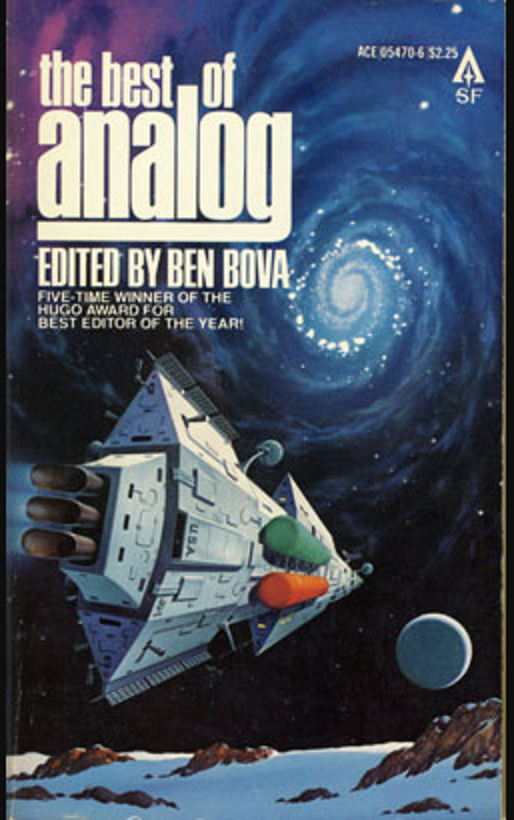Book Review: The Best of Analog edited by Ben Bova
After the death of long-time editor John W. Campbell in 1971, Analog Science Fiction and Fact needed a new person at the helm. The winner of the selection process was Ben Bova (1932-2020), who intended to stay only a few years, those years winding up as 1972-1978, after which Stanley Schmidt (1944-present) was persuaded to take over. This volume collects fifteen of Mr. Bova’s favorite pieces from the magazine from the first five years of his award-winning run.

After a brief introduction by Ben Bova explaining why he picked these particular pieces, the volume begins with “Persephone and Hades” by Scott W. Schumack. After World War Three made the surface of Earth uninhabitable, effectively immortal cyborg Robert Carver believed that he was the last human being alive in his underground research vault. The damage had also caused the cryogenically preserved terminal patients to thaw just enough to kill them.
Except, as it happened, one that had been in a new model cryochamber that was able to sustain her until the power was turned back on, and was accidentally woken up by Carver some years later. Carver had gone a bit nuts from the isolation and decided that Carol Armendez was a threat to his plan to restart life on Earth from the stored genetic material in the vault. She recognized he was unbalanced, and they started a cat and mouse game that eventually causes Carver to realize where he’d gone wrong, and how much he needs Armendez.
“Home is the Hangman” by Roger Zelazny is the closing story. It’s part of a series he did about a Twenty-First Century in which most of humanity has been entered into a central Data Bank. The protagonist was present at the creation of that data bank and somehow contrived to have none of his personal information or history entered into it, making him effectively a “non-person” as far as the government or other large entities that rely on computers are concerned.
He stays off the grid most of the time, but his special skills and anonymity make him useful for an old friend who runs a private security agency from time to time. In this case, a self-aware “robot” that was being used to explore other planets in the solar system appears to have returned to Earth. One of the four operators who trained it has been brutally murdered, and another one, now a United States Senator, believes that the Hangman has come back for revenge (though he won’t explain for what.)
The protagonist takes on the name John Donne and begins investigating. Can he stop the Hangman? Should in fact the Hangman be stopped?
This one’s heavy on the literary allusions (the title is a riff on a Robert Louis Stevenson poem) and philosophical musings about the nature of intelligence and free will. (I remember really liking the cover of the Analog issue this story appeared in.)
Other standouts include:
“How I Lost the Second World War and Helped Turn Back the German Invasion” by Gene Wolfe is an amusing alternate history story in which a wargamer participates in a “parking race” to prevent Adolf Hitler from flooding the British automobile market with “People’s Wagons.” The “science” part comes in from the properties of transistors, a new technology invented years earlier in this timeline. This was the story that reminded me I’d read this volume years ago. It may not be the best, but it’s very memorable.
“A Song for Lya” by George R.R. Martin was his first story accepted by Analog, and won him a Hugo award. A pair of romantically involved psychics are summoned to a colony world where humans are adopting the native religion. Which might not be a problem, except that the worshippers allow themselves to be slowly eaten by an alien organism, eventually being absorbed into it. But it might not be the suicide it seems. The ending is melancholy.
“A Thing of Beauty” by Norman Spinrad is about ten years ahead of its time in its “Japan takes over the world” future. The United States’ economy took a nosedive and a sketchily-mentioned “insurrection” made the formerly proud America a third-world nation. The main character is an antiquities dealer who’s selling off bits and pieces of his country’s heritage to the still prosperous Japanese. In this case, a fabulously wealthy industrialist, Mr. Ito, is in the market for a thing of beauty to impress his snooty in-laws.
The dealer tries several pieces that do not please Mr. Ito, but then a surprise item presents itself, and the story ends with a final esoteric joke.
The general quality of stories (plus one poem and a fictitious article) is high; this was a strong run of the magazine. I do have to put in a content note for “Child of All Ages” by P.J. Plauger, which has discussion of what amounts to pedophilia.
This doesn’t seem to have been reprinted since 1979, so you may have to search used bookstores or check to see if a particular story that sounds good was reprinted elsewhere. Recommended to science fiction fans with an interest in the early 1970s state of the field.

